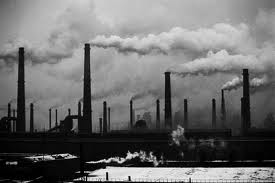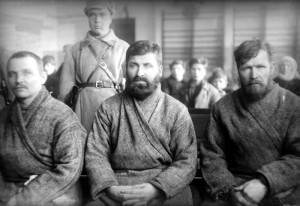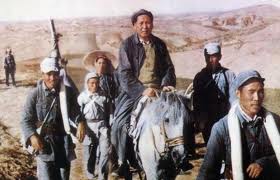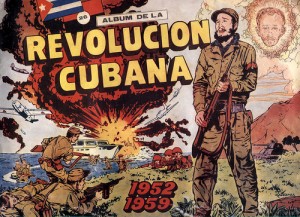COMPETITORS
Aug 4th, 2011 by amcadams
12. LECTURE: Monday, September 19.
“Enemies of the People.” High Stalinism was an era of extremes. Some of these extremes were reflected in the explosive growth of the Soviet economy in the 1930s and the glorification of the “heroic worker,” as you can see in these images of the Stakhanovite movement (video) and in the construction of the industrial city,  Magnitogorsk (video). But, there were also the indescribable and incomprehensible extremes of Stalin’s purges and nothing less than the systematic extermination of the old communist elite. It is both disturbing and puzzling to think that so many people (video) went along with these polices. For the Soviet Union, the suffering was devastating, as these slides attest. But paradoxically, many people, both high officials and ordinary Russians, seemed to love Stalin all the more,
Magnitogorsk (video). But, there were also the indescribable and incomprehensible extremes of Stalin’s purges and nothing less than the systematic extermination of the old communist elite. It is both disturbing and puzzling to think that so many people (video) went along with these polices. For the Soviet Union, the suffering was devastating, as these slides attest. But paradoxically, many people, both high officials and ordinary Russians, seemed to love Stalin all the more,  as you can see in this video and this hymn.
as you can see in this video and this hymn.
-
“Z”, “To the Stalin Mausoleum,” section VI.
-
Arthur Koestler, Darkness at Noon. Read the first half of the book.
-
Nikolai Bukharin’s secret letter to Stalin, December 10, 1937: HERE
13. EVENING FILM: “Interrogation“
You will be able to choose between two showings of this required film.
First Showing of “Interrogation”: Monday, September 19, at 7:00 pm in 114 Pasquerilla Center
Second Showing of “Interrogation”: Tuesday, September 20, at 7:00 pm in 114 Pasquerilla Center
14. LECTURE: Wednesday, September 21
The Stalinist Model spreads to East-Central Europe. In this lecture, I jump a bit into the future to examine Stalinism’s impact on other European settings immediately after WWII.
- Wolfgang Leonhard, Child of the Revolution, “The Comintern School,” in your Course Reader.
YOUR FIRST ESSAY ASSIGNMENT IS HERE
15. DISCUSSION SECTION: Friday, September 23
In this section, focus on Koestler’s portrayals of communist leaders and followers. What are the functions served by characters like Rubashov, Ivanov, Little Loewy, Richard, Arlova, and Gletkin?
-
Arthur Koestler, Darkness at Noon. Complete the book.
-
Reread Nikolai Bukharin’s secret letter to Stalin, December 10, 1937: HERE
Paragraph: What is Koestler’s theory about why some of the old Bolsheviks went along with the trumped up charges against even themselves? Is his explanation satisfactory? Compare his argument with Bukharin’s secret letter to Stalin.
16. LECTURE: Monday, September 26
The Path of Armed Struggle. Now that we have considered Stalin’s rise to power, I will address the Chinese revolution and the quite different path that  Mao Zedong followed, especially during the formative period of the “Long March” of 1934-1935. Mao’s ability to foment revolution in the countryside occurred as much because of the unintended consequences of others’ actions as it did of his own designs. There is no greater symbol of Chinese communism than the Long March. See the map of the Long March: HERE
Mao Zedong followed, especially during the formative period of the “Long March” of 1934-1935. Mao’s ability to foment revolution in the countryside occurred as much because of the unintended consequences of others’ actions as it did of his own designs. There is no greater symbol of Chinese communism than the Long March. See the map of the Long March: HERE
- William Rosenberg and Marilyn Young, Transforming Russia and China, pp. 135-47.
- Mao Zedong, “Rectify the Party’s Style of Work,” February 1, 1942: HERE (Print)
17. LECTURE: Wednesday, September 28
The Path of the Populist Revolutionary. Today, I will consider the path to power of two populist revolutionaries, Fidel Castro and (at least mythologically) Kim Il-Sung. Just as in China, guerrilla warfare had a decisive impact on Cuban and North Korean communism. In fact, Castro only proclaimed his allegience to world communism after coming to power. To get a feel for the distinctive culture of Cuban socialism, watch these interviews (video) with some of Fidel’s former guerrilla fighters. Likewise, one cannot overstate the distinctive character of North Korean communism. Here’s a little “Arirang” (North Korean Mass Games). Death of the Great Leader Kim Il-sung.
- Fidel Castro, “The Revolution Begins Now” (excerpt), January 3, 1959: HERE (Print)
- Brief background on Fidel and the
 Cuban revolution: HERE
Cuban revolution: HERE - Background on North Korea, “Origins of the Democratic People’s Republic of Korea”: HERE
- Kim Il-sung, “On Eliminating Dogmatism and Formalism and establishing Juche in Ideological Work” (1955): HERE
18. NO DISCUSSION SECTION: Friday, September 30
We will not have discussion sections this week because you have been writing your papers. Your TA will make arrangements for you to turn in your paper.
.
The use of electronic devices of any kind, including laptops, cell phones, film projectors, video cameras, and personal digital devices, is prohibited in my classroom!
Top of Page · Founders · Competitors · Defenders · Reformers · Losers